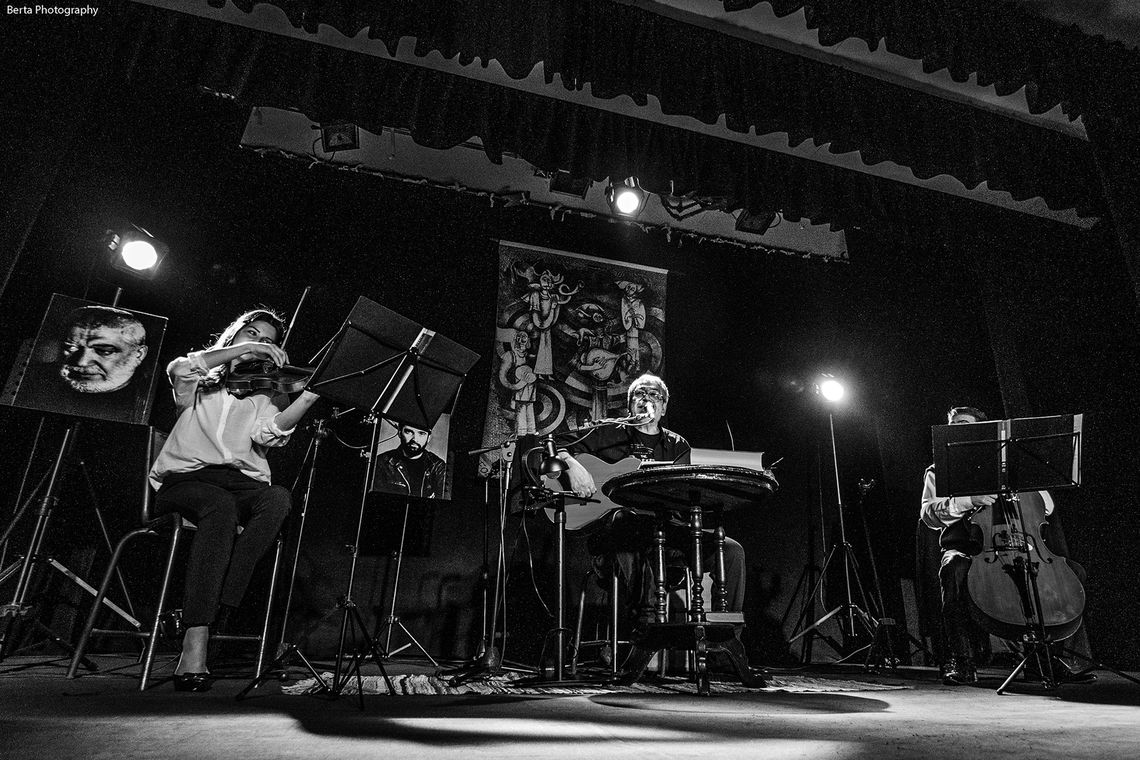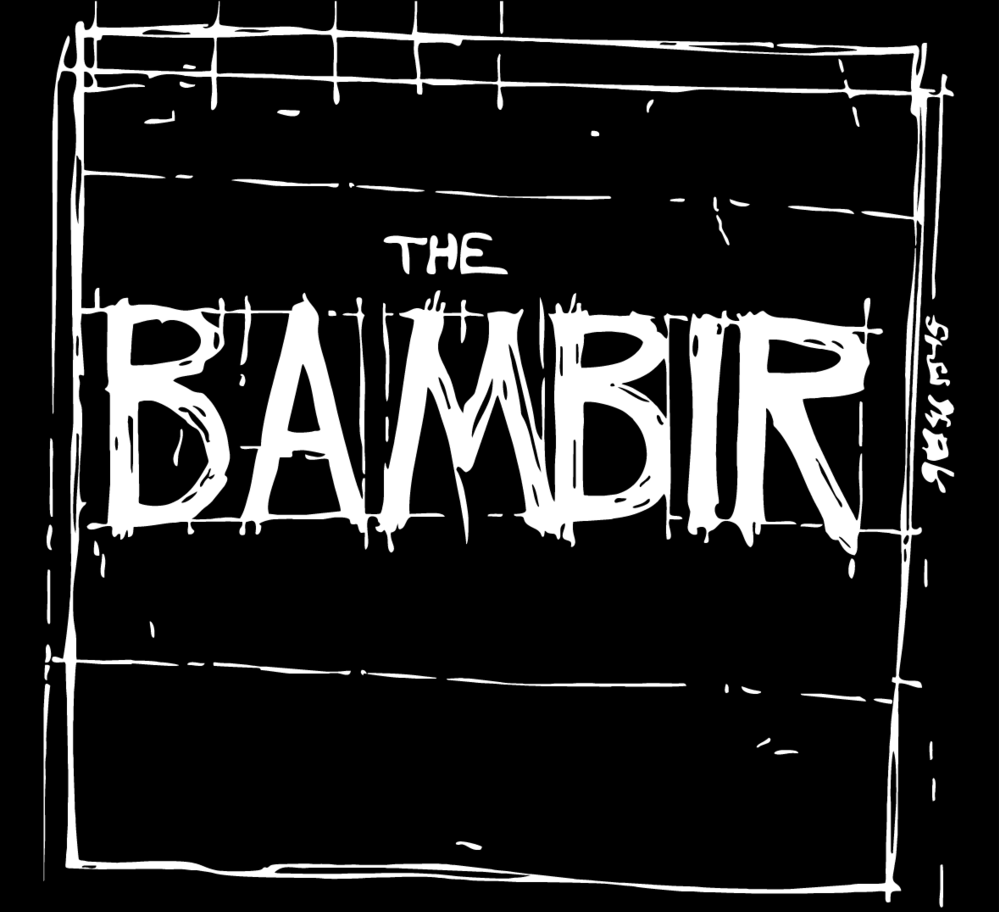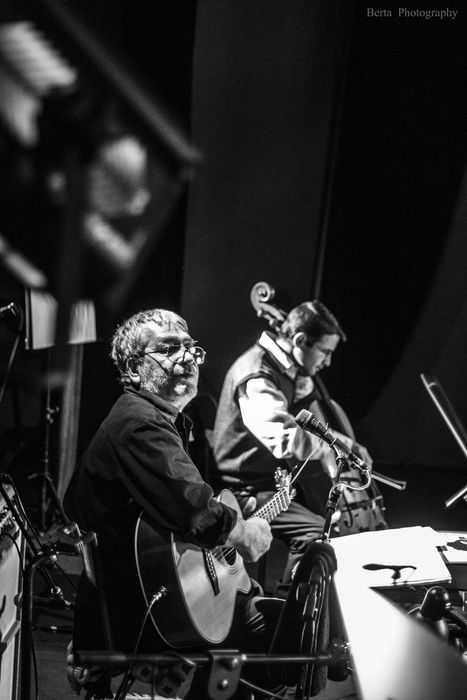
Both Jag and Bambir became recognized artists in the Soviet Union during the late 1970s and 1980s known for their unique arrangements of Komitas, traditional Armenian songs, medieval Armenian music, and their own original material.
The momentum all came crashing to a halt after a devastating earthquake hit Armenia in December 1988, with its epicenter near Leninakan.
Suddenly, music took a backseat to more important things such as survival.
Review: April 9, 2017, 19:00
Jag Bambir-"Teatron"
Vardan Ajemyan State Drama Theatre in Gyumri, Small Theater After Mher Mkrtchyan
Gyumri, Armenia
As people slowly began filing into the small but distinct theater in Gyumri to see Jag Bambir, the feeling was less formal and more familial. The stocky, slightly older red-haired usher who was directing patrons to their gently worn crushed red velvet seats assured guests that their view and the sound would just be fine. Her breathy and efficient cajoling of local patrons seemed fitting in the self proclaimed “Capital of Humor.” The near sold-out crowd were all Gyumri residents here to see a local legend without any fanfare. Indeed, Jag Bambir had drawn an audience eager to experience his latest creation, TEATRON. He didn’t disappoint.
Gagik Barseghyan (Jag) was born in Yerevan, Armenia in 1954 and moved to Leninakan (present day Gyumri) during his early twenties. An early pioneer of the rock and roll movement in the former Soviet Union, he and his friends founded a band called Angin Karer (precious stones) in the early 1970s which morphed into the first version of what eventually would become his signature band called Bambir. A bambir is an ancient instrument similar to a cello, but also is referenced as a local bard (gusan).

Bambir’s musical collective has survived over 35 years with about 40 members having passed through the ranks. In recent years, Jag has transitioned the legacy name of the band to his son Narek, and core members Arik Grigoryan, Arman Kocharyan (son of the original member of Angin Karer), and Vardan Paremuzyan now renamed, The Bambir.

His band was named Bambir by sculptor Zaven Koshtoyan after hearing the newly formed ensemble in 1978. Since Barseghyan and his band played Rolling Stone covers, his fans started to call him “Jag,” short for the lead singer Mick Jagger. Over time, the nickname stuck. “Ninety percent of people who liked rock music gravitated towards The Beatles during those days, the remaining 10 percent of us preferred the Rolling Stones,” he explained. As such, both Jag and Bambir became recognized artists in the Soviet Union during the late 1970s and 1980s known for their unique arrangements of Komitas, traditional Armenian songs, medieval Armenian music, and their own original material.
The momentum all came crashing to a halt after a devastating earthquake hit Armenia in December 1988, with its epicenter near Leninakan. Suddenly, music took a backseat to more important things such as survival.
Bambir reemerged in 1999 to release what would be their debut album entitled, “Quake.” A ten track program that blended their signature reworkings of Armenian folk music with an ambitious original folk-rock suite called “Earthquake” received little to no attention. In 2003, a repackaged, remastered, and resequenced version of “Quake” (Pomegranate Music) was released to a wider world music audience garnering a 4-star review from AllMusic Guide’s Rick Anderson with Paul-Emile Comeau of Global Rhythm Magazine proclaiming the effort a “tour de force.” Before year's end, Bambir would release another album in limited quantities called “J and G” (Jesus and Gregory), in celebration of Armenia’s 1700 year anniversary adopting Christianity as their state religion. The 20 track, one hour masterpiece is arguably their best recorded work showing off their intellectual and musical chops as never before. The rock opera format took over two years to record with over 20 musicians utilized. Along with “Quake,” “ J and G” is regarded as their high water mark as far as recorded materials. An additional two albums were released in 2005 and 2011 respectively entitled, “Blind Alley” and “Armenian Scotch” which certainly yielded bright spots, but never reached the emotional heft or grand scope of their first two outputs.

Jag’s poignant and moving concert was soul stirring and a reminder that music was once an artform and not a product to be peddled.
The ten song, eighty minute Teatron set featuring his familiar gravelly voice that is a combination akin to a pirate and Tom Waits with a Celtic tinge.
His choice to present the program theatrically and in a chronological format was wise as it provided a sort of career retrospective in concert.

Barseghyan resides as patriarch over Bambir’s musical collective that has survived over 35 years with approximately 40 members having passed through the ranks. In recent years, he has transitioned the legacy name of the band to his son Narek, and core members Arik Grigoryan, Arman Kocharyan (son of the original member of Angin Karer), and Vardan Paremuzyan now renamed, The Bambir. Gagik Barseghyan currently performs under the stage name, Jag Bambir, distinguishing himself and his style from the younger generation of musicians now assuming the Bambir flagship name.
As the curtain rose on this particular evening, Jag Bambir was flanked by violinist Anna Kocharyan on one side and cellist Grigor Mirzoyan on the other. The stage was adorned with three covered tripods, a drama mask, and a distinctive painting by Vahan Topchyan stage back. Jag’s ten song, eighty minute set featuring his familiar gravelly voice that is a combination akin to a pirate and Tom Waits with a Celtic tinge. He started with “The Theater’s Ghost” and Jrahars (Mermaid), early Bambir songs rarely heard. Interspersed between songs, Jag Bambir quoted passages from Shakespeare, Levon Shant, Perch Zeytuntsyan, Hovhannes Tumanyan, and various Chinese philosophers. At times, he picked up the drama mask and spoke to it, while at other times he asked for its wisdom.
Musically, the show hit its stride early on as he performed “Dying Fall” from his “Earthquake Suite” followed by a selection from “J and G” entitled “Come Down, My Dreams.” At other times, Jag Bambir walked over to the tripods removing the covers revealing pictures of past theater directors, including Grigor Mkrtchyan who passed away days before the concert. Somberly uttering “Akh Varbed” for his dear mentor and teacher, Jag Bambir asked the crowd to rise in a moment of silence before continuing with the rest of the program which included selections from “Blind Alley,” “Armenian Scotch” in addition to a new song called “Blue Orb” and finally finishing with an old favorite, “Lennakan” (sic) which had the audience clapping in unison as if to validate the piece as a new folk song.
His choice to present the program theatrically and in a chronological format was wise as it provided a sort of career retrospective in concert not expected by this writer. While the occasional pre-recorded backing tracks seemed out of place at times, it was necessary sonic filler to go along with him and his guitar and the other stringed instruments onstage. Jag Bambir’s poignant and moving concert was soul stirring and a reminder that music was once an artform and not a product to be peddled.
*******************
In a followup visit to Jag’s place in Gyumri, my friend and I engaged in initial small talk with him and his wife Anahit until Jag started to open up. He discussed the migration patterns of gypsies, a version of James Joyce’s Ulysses, an update on his current translation of the Tao Te Ching, as well as showing us his latest musical instrument he picked up in Istanbul to go along with the others that hung on his wall, including a bambir.
Jag then opened up a book with laminated pages of Armenian script and started reading passages of songs from his next album, about a young boy emerging into manhood. One of those passages was about the number of Russian women who used to stream into Leninakan to work in the textile factories. They would come to the city and live in dormitories, often times marrying local Armenians. He spoke of the heydays of Leninakan, a city that used to have over 200,000 people having now dwindled down to approximately 90,000. Interestingly enough, Jag spoke in a matter-of-fact fashion, not at all the nostalgic tone I was expecting.
Jag is an artist in every sense of the word. Cut from the cloth of people whose purpose in society was to learn, create, and share with those around them.
As we started to make our way out of Jag and Anahit’s modest apartment, he stopped and made sure that he conveyed a couple of last thoughts. He first asked us to identify Gyumri as Leninakan, because the etymology of the current name of the city is Turkish in origin. But finally, he said, “You know, I just want to clarify one last thing. Bambir means a bard, not a minstrel - a gusan, not an ashugh. Because, a bard is more noble, more respected, and a minstrel is more of a street singer. A bambir is a bard.”
As my friend and I said our goodbyes to Jag, I couldn’t help thinking if we hadn’t just seen the last bard of Leninakan.




